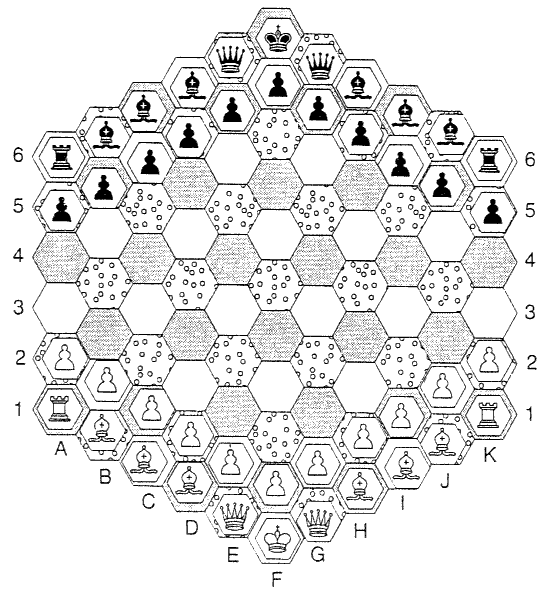Variant Chess Index
 THE MAGAZINE TO BROADEN YOUR CHESS HORIZONS | ||
| Volume 7, issue 46 | ISSN 0958-8248 | November 2004 |
|
...And A New Game reviewed by David Pritchard Honeycomb Chess by Douglas Reid (A4 format - 64pp) £12.50 | |
|
Honeycomb Chess, an invention of the author, is a variant played on a regular 91-hex board (i.e., equivalent to Glinskis) with 22 men a side. The pieces are: 1 x king; 2 x queen, rook; 6 x hopper; 11 x pawn. The hopper, represented in diagrams by a bishop, moves directly to the nearest hex of the same colour complex (a hex board has three colour complexes, regularly arranged so that no two hexes of the same colour are adjacent to each other). This gives the hoppers move a choice of six cells if away from the board edge, three if in a corner and four if on a side. The initial array is shown. Notice that there are three hoppers on each side of the board. Like-hex hoppers can of course protect each other. The rooks move on files or laterally through cells of the same colour complex. This means that a rook has access only to alternate files. Since both rooks start on the same coloured hexes, they can support each other but together cover only half the board. This can be resolved by castling, which is regular (king moves three hexes in either direction, etc.) when the castled rook has access to the other half of the board. It follows that after castling the rooks can never attack the same square or protect each other. |
Pawns have a two-cell initial move option, promote on an end hex and can be captured en passant. The moves of the king and queen are orthodox (any direction; in the case of the queen, along adjacent hexes only). A weakness of the game is that the wing pawns are only three squares from promotion whereas the central pawns, the worst placed, are eight moves away. Despite the presence of the pair of queens, the game plays slowly, the average game running to 60-odd moves. The book covers the rules, the opening, middle-game and end-game and four annotated games. This is surely a must-buy for chess book collectors as the first edition is limited to just one hundred numbered copies. Write: Douglas Reid, Flat 106, 120-124 Sackville Court, Harold Wood, Romford, Essex RM3 0ED |
 |
|
Selected articles from Variant Chess appear here on the Chess Variant Pages with the permission of the British Chess Variants Society (BCVS). We feel that this journal is exceptional, and have entered into an agreement with the BCVS to publish certain of their articles on our pages in return for advertising.
